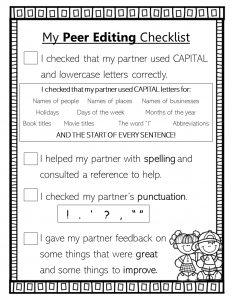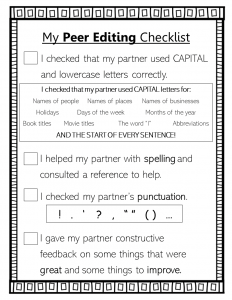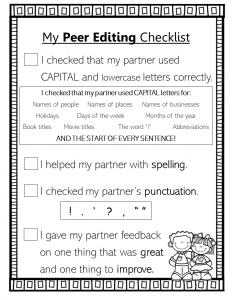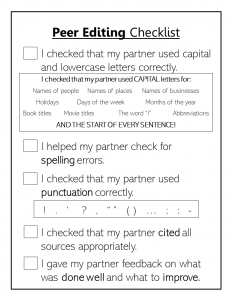Ever had your students swap papers for peer editing or revisions, only to have the feedback go no deeper than, “I like your work because the picture is so colorful”? Enter the student-friendly peer editing checklist – it’s like a treasure map for finding the golden nuggets in writing (and the not-so-shiny bits that could use a polish.) It’s a great way to get kids thinking about the things that make good writing good, and the fixes that make less-strong writing stronger.
What is a Peer Editing Checklist?
Think of a peer editing checklist as a roadmap that lets students know exactly what they should be looking for in a classmate’s writing.
Different grade levels will need different versions, but a good peer editing checklist will often include reminders like checking for those sneaky capital letters that so often go AWOL, hunting down the punctuation that plays hide and seek, and giving a thumbs up or some friendly advice on what’s great and what’s not in the writing piece.
A good peer editing checklist should also be kid-friendly – the language on the checklist shouldn’t be ten times more complex than the language in the writing piece itself!

Why Use Peer Editing Checklists?
- Keeps the Eyes on the Prize: The checklist keeps kiddos zeroed in on what to look for, so they don’t end up just praising the cool handwriting.
- No More Guesswork: It lays out all the things they should comment on, clear as day.
- Fair’s Fair: Makes sure everyone’s writing gets the same eagle-eyed treatment.
- Brain Gains: Kids get to flex their thinking muscles by playing detective with their buddy’s work.
- Teamwork Makes the Dream Work: It’s all about working together to make those writing pieces shine.
- Taking Charge: Students often up their game when they know a classmate will be peeking at their paper.
- Level Up Writing Skills: Regular swapping and reviewing can lead to a class full of word wizards.

Making Peer Editing Checklists Work for Your Classroom
Show and Tell
First, walk your students through the checklist. Talk through each item on the checklist, and discuss why it’s important.
Practice Run
Do a mock edit together. Grab a piece of writing, project it up on the board, and let the class have at it, checklist in hand. I always tell students to read the whole piece through for every single checklist item. So, if the first thing on the checklist is looking for capital letters, we read the whole piece and only correct capital letters. Then we do it again, looking for punctuation. Etc., etc., until everything on the checklist has that friendly little checkmark next to it.
Buddy System
Pair up the students and let them have a go. You can do homogenous or heterogenous pairing, but for the first run I often like to pair students with similar writing levels. This way, both students in the pair will feel like they really have something to contribute. Encourage students to be kind but honest – it’s all in the name of making the writing better, after all.
Reflection Time
Once the editing’s done, get your students to reflect. What did they learn? Did they spot similar issues in their own work?
Feedback Fiesta
Make peer editing a celebration, not a chore. When they’ve done a solid job giving feedback, let them know it’s a big deal! After all, giving constructive feedback is something that many adults even struggle to do!

Watch Out: Common Pitfalls of Peer Editing (And How to Dodge Them)
Peer editing is like navigating through a jungle gym – it’s a blast, but you gotta watch where you’re stepping. Here are some common slip-ups that can happen and how to swing past them:
1. The “Nice Job!” Trap
We’ve all seen it – the peer editing process is complete, and only compliments have been given. Super sweet, but not super helpful. If you have students who are hesitant to actually edit their peers work, sometimes some special writing tools can help. Colored pencils, colored pens… let students use these to mark up their classmates’ work. You can even have a different color assigned for each checklist item. The first draft may come away looking messy, but isn’t that really the goal?
2. The Overwhelm
Sometimes a checklist can look like a to-do list that never ends, and students might just shut down. To avoid this, break it down as a whole group before sending them off to edit. Show them how to tackle one item at a time, so they don’t feel like they’re trying to juggle while balancing books on their heads.
If you find that your students are still struggling, take a step back. Choose one checklist item to really focus on for the day.
You can also differentiate peer editing checklists by just chopping off sections of some of them. Some students might be working with the whole checklist, and others just have one or two items to be on the looking for.
3. The Harsh Critic
There’s always that one student who fancies themselves the Simon Cowell of writing. To prevent any tears or crumpled papers, chat about constructive criticism. If you foresee this being a problem, maybe even role-play on how to deliver the “tough love” in a way that’s more love, less tough.
4. The Rush Job
Time’s ticking, and suddenly, peer editing turns into a race. Slow it down by drawing positive attention to the students who are really taking their time! I like to start the process by letting students know that in my past experience as a teacher, those who take the most time to edit usually do the best job. Then, as students are working, I’m constantly calling out, “Wow, Jayden hasn’t even checked off the first item yet. He must be doing a super thorough job. Thanks, Jayden!”
5. The “What Did I Just Read?”
Confusion can set in, especially with younger students or those who really struggle with writing. If a student doesn’t understand their peer’s writing, have them ask their peer to tell them what they meant to say. Most students are clearly able to explain their intentions orally. Then, the duo can work together to get the writing on paper, in a brand new draft if necessary.

Ready to Try Peer Editing Checklists in Your Classroom?
Peer editing with checklists is like giving students a map, a compass, and a pat on the back before they set off on an adventure. I have peer editing checklists available for every grade level from 2nd grade through high school! They’re designed to meet each grade level’s specific standards for writing and editing. Check them out:
- 2nd grade peer editing checklist
- Peer editing checklist for 3rd grade, 4th grade, & 5th grade
- Peer editing checklist for 6th grade, 7th grade, & 8th grade
- High school peer editing checklist
You might also be interested in:
Using poems to improve reading fluency
Teaching word problems with tape diagrams